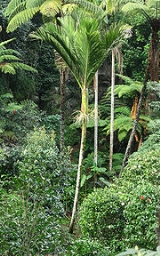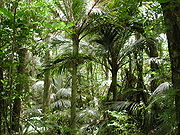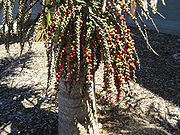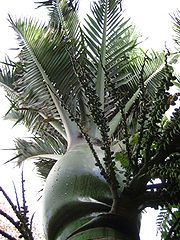
Nikau
Encyclopedia
Nikau is a palm
tree, the only palm endemic
to New Zealand
.
word; in the closely related Eastern Polynesian languages
of the tropical Pacific, it refers to the fronds or the midrib of the coconut palm
.
 The Nikau palm is the only palm species endemic to mainland New Zealand. Its natural range is coastal and lowland forest on the North Island
The Nikau palm is the only palm species endemic to mainland New Zealand. Its natural range is coastal and lowland forest on the North Island
, and on the South Island
as far south as Okarito (43°20′S) in the west and Banks Peninsula
(43°5′S) in the east. It also occurs on Chatham Island and Pitt Island/Rangiauria
to the south-east of New Zealand, where it is the world's southernmost palm at 44° 18'S latitude.
The Nikau grows up to 15 m tall, with a stout green trunk which bears grey-green leaf scars. The trunk is topped by a smooth bulging crownshaft
up to 1m long. The fronds are up to 3m long, and the closely set, sometimes overlapping leaflets are up to 1 m long. The inflorescence is multi-branched and from 200 to 400 mm long. The tightly packed flowers are unisexual and coloured lilac to pink. Male flowers are borne in pairs, and have 6 stamens. The female flowers are solitary. The fruit is elliptic or oblong, and generally measures about 10 by 7 mm, and is red when ripe. The Nikau produces flowers between November and April, and fruits ripen from February to November, taking almost a year to fully ripen. These are a preferred food of the Kererū, the native wood pigeon.
 The Nikau makes an excellent pot plant, and is quite hardy. It tends to be slow-growing. It grows readily from seed if the fruit is soaked in water for a few days and then gently scrubbed to remove the flesh. The seed will then germinate readily if placed in sealed plastic bags in semi-shade, after which they can be planted in deep pots. The pots should be tall and narrow to provide room for the taproot and to lessen the likelihood of root damage when transplanting.
The Nikau makes an excellent pot plant, and is quite hardy. It tends to be slow-growing. It grows readily from seed if the fruit is soaked in water for a few days and then gently scrubbed to remove the flesh. The seed will then germinate readily if placed in sealed plastic bags in semi-shade, after which they can be planted in deep pots. The pots should be tall and narrow to provide room for the taproot and to lessen the likelihood of root damage when transplanting.
Transplanting juveniles is generally successful if the main root is left intact. The Nikau does not have a true tap root. Once the main root has been established to a fairly shallow depth of about 400 mm) its roots take on form consistent with other palms. Successful transplanting is possible but the Nikau is very fickle if there's any trunk. It is best done in summer but a substantial root ball should be preserved, and shade should be provided at the new location - at the very least by tying the outer fronds closer to the centre. Ground watering is recommended because crown watering can induce terminal rot at the very slow growing new spike. Delays should be avoided in getting the Nikau into its new ground and substantial die-back of all but the central spike can be expected.
The Nikau thrives on cool temperatures but is not subject to freezing weather in its natural habitat. It can survive a few degrees of frost, but it is damaged even more severely by sudden large drops in temperature even above freezing. This makes it unsuitable in cultivation for places like Florida where severe cold snaps occur regularly. It does well in areas with a mild Mediterranean climate.

 The Nikau palm shows considerable variation in the wild. Plants from the South Island and the offshore islands of the North Island have larger, more gracefully arching fronds and are popular in cultivation. The Chatham Islands
The Nikau palm shows considerable variation in the wild. Plants from the South Island and the offshore islands of the North Island have larger, more gracefully arching fronds and are popular in cultivation. The Chatham Islands
form is particularly different, having a distinct juvenile form and larger fruits, and a thicker covering of fine hairs on the fronds. More research is needed into its precise relationship with the mainland form. The New Zealand Nikau palm is very similar to Rhopalostylis baueri
of the Kermadecs
and Norfolk Island
, which can be distinguished by its more rounded or oval fruits, and by its leaflets which are broader than those found in most populations of R. sapida.
s, floor mats
, and waterproof thatch
for buildings.
Arecaceae
Arecaceae or Palmae , are a family of flowering plants, the only family in the monocot order Arecales. There are roughly 202 currently known genera with around 2600 species, most of which are restricted to tropical, subtropical, and warm temperate climates...
tree, the only palm endemic
Endemic (ecology)
Endemism is the ecological state of being unique to a defined geographic location, such as an island, nation or other defined zone, or habitat type; organisms that are indigenous to a place are not endemic to it if they are also found elsewhere. For example, all species of lemur are endemic to the...
to New Zealand
New Zealand
New Zealand is an island country in the south-western Pacific Ocean comprising two main landmasses and numerous smaller islands. The country is situated some east of Australia across the Tasman Sea, and roughly south of the Pacific island nations of New Caledonia, Fiji, and Tonga...
.
Etymology
Nīkau is a MāoriMaori language
Māori or te reo Māori , commonly te reo , is the language of the indigenous population of New Zealand, the Māori. It has the status of an official language in New Zealand...
word; in the closely related Eastern Polynesian languages
Eastern Polynesian languages
The dozen Eastern Polynesian languages are found on Pacific Islands from Hawaii in the north, to New Zealand in the southwest, to Easter Island in the southeast...
of the tropical Pacific, it refers to the fronds or the midrib of the coconut palm
Coconut
The coconut palm, Cocos nucifera, is a member of the family Arecaceae . It is the only accepted species in the genus Cocos. The term coconut can refer to the entire coconut palm, the seed, or the fruit, which is not a botanical nut. The spelling cocoanut is an old-fashioned form of the word...
.
Distribution

North Island
The North Island is one of the two main islands of New Zealand, separated from the much less populous South Island by Cook Strait. The island is in area, making it the world's 14th-largest island...
, and on the South Island
South Island
The South Island is the larger of the two major islands of New Zealand, the other being the more populous North Island. It is bordered to the north by Cook Strait, to the west by the Tasman Sea, to the south and east by the Pacific Ocean...
as far south as Okarito (43°20′S) in the west and Banks Peninsula
Banks Peninsula
Banks Peninsula is a peninsula of volcanic origin on the east coast of the South Island of New Zealand. It has an area of approximately and encompasses two large harbours and many smaller bays and coves...
(43°5′S) in the east. It also occurs on Chatham Island and Pitt Island/Rangiauria
Pitt Island/Rangiauria
Pitt Island or Rangiauria is the second largest island in the Chatham Islands, originally known as Rekohu.There is a School, a wharf, a church and a landing strip for light planes on Pitt Island. Air Chathams provide the light plane service between the islands. As there is no shop on the island, a...
to the south-east of New Zealand, where it is the world's southernmost palm at 44° 18'S latitude.
The Nikau grows up to 15 m tall, with a stout green trunk which bears grey-green leaf scars. The trunk is topped by a smooth bulging crownshaft
Crownshaft
An elongated circumferential leaf base formation present on some species of palm is called a crownshaft.The leaf bases of some pinnate leaved palms form a sheath at the top of the trunk surrounding the bud where all the subsequent leaves are formed.The crownshaft...
up to 1m long. The fronds are up to 3m long, and the closely set, sometimes overlapping leaflets are up to 1 m long. The inflorescence is multi-branched and from 200 to 400 mm long. The tightly packed flowers are unisexual and coloured lilac to pink. Male flowers are borne in pairs, and have 6 stamens. The female flowers are solitary. The fruit is elliptic or oblong, and generally measures about 10 by 7 mm, and is red when ripe. The Nikau produces flowers between November and April, and fruits ripen from February to November, taking almost a year to fully ripen. These are a preferred food of the Kererū, the native wood pigeon.
Cultivation

Transplanting juveniles is generally successful if the main root is left intact. The Nikau does not have a true tap root. Once the main root has been established to a fairly shallow depth of about 400 mm) its roots take on form consistent with other palms. Successful transplanting is possible but the Nikau is very fickle if there's any trunk. It is best done in summer but a substantial root ball should be preserved, and shade should be provided at the new location - at the very least by tying the outer fronds closer to the centre. Ground watering is recommended because crown watering can induce terminal rot at the very slow growing new spike. Delays should be avoided in getting the Nikau into its new ground and substantial die-back of all but the central spike can be expected.
The Nikau thrives on cool temperatures but is not subject to freezing weather in its natural habitat. It can survive a few degrees of frost, but it is damaged even more severely by sudden large drops in temperature even above freezing. This makes it unsuitable in cultivation for places like Florida where severe cold snaps occur regularly. It does well in areas with a mild Mediterranean climate.
Variation


Chatham Islands
The Chatham Islands are an archipelago and New Zealand territory in the Pacific Ocean consisting of about ten islands within a radius, the largest of which are Chatham Island and Pitt Island. Their name in the indigenous language, Moriori, means Misty Sun...
form is particularly different, having a distinct juvenile form and larger fruits, and a thicker covering of fine hairs on the fronds. More research is needed into its precise relationship with the mainland form. The New Zealand Nikau palm is very similar to Rhopalostylis baueri
Rhopalostylis baueri
Rhopalostylis baueri is a species of palm native to Norfolk Island and to the Kermadec Islands . Norfolk Island is the type locality. The common names on Norfolk Island are 'Norfolk Island Palm' or 'Niau'...
of the Kermadecs
Kermadec Islands
The Kermadec Islands are a subtropical island arc in the South Pacific Ocean northeast of New Zealand's North Island, and a similar distance southwest of Tonga...
and Norfolk Island
Norfolk Island
Norfolk Island is a small island in the Pacific Ocean located between Australia, New Zealand and New Caledonia. The island is part of the Commonwealth of Australia, but it enjoys a large degree of self-governance...
, which can be distinguished by its more rounded or oval fruits, and by its leaflets which are broader than those found in most populations of R. sapida.
Uses
The Maoris found many uses for the Nikau palm. The bases of the inner leaves were eaten raw or cooked, also the young flower clusters. Food was wrapped in the leaves for cooking, and the old fibrous leaves were used for basketBasket
A basket is a container which is traditionally constructed from stiff fibres, which can be made from a range of materials, including wood splints, runners, and cane. While most baskets are made from plant materials, other materials such as horsehair, baleen, or metal wire can be used. Baskets are...
s, floor mats
Mat
A mat is a generic term for a piece of fabric or flat material, generally placed on a floor or other flat surface, and serving a range of purposes including:* providing a regular or flat surface, such as a mousepad....
, and waterproof thatch
Thatching
Thatching is the craft of building a roof with dry vegetation such as straw, water reed, sedge , rushes, or heather, layering the vegetation so as to shed water away from the inner roof. It is a very old roofing method and has been used in both tropical and temperate climates...
for buildings.

